Translated in 
Mars is the fourth planet in our Solar System. Its a
small planet, only 53% that of
Earth, and receives
half as much sunlight as
Earth. Things on Mars
weighs 40% that of
Earth and as a result of this the
atmosphere is much thinner. The atmospheric pressure
is only 0.01atm compared to
Earth's 1atm
(1atm = 1
Earth
atmospheres) and
Venus'
90atm. As expected the
temperature is also much
cooler.Take a look at the
Spirit and Opportunity slide shows.
The data is in: water did flow on Mars in the past. What's more is that water is still on Mars mixed with the soil in the northern aortic region. Soil analysis from the Phoenix lander also shows that Mars had a warmer, wetter past.
And to NASA's surprise, the MER's Spirit and Opportunity are still studying Mars as of August 10, 2009!
Mars - A Quick Summary: (More information can be found on the Mars Fact Sheet)
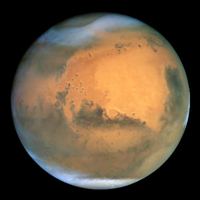 |
Average Distance from Sun: |
2.279 x 108 km |
| Eccentricity of Orbit: |
0.093 |
| Average Orbital Speed: |
24.1 km/s |
| Orbital Period: |
686.98 days |
| Rotational Period: |
24h 37m 22s |
| Inclination of Equator to
Orbit: |
25.19º |
| Diameter: |
6794 km |
| Mass: |
6.418 x 1023 kg |
 |
Average Density: |
3934 kg/m3 |
| Escape Speed: |
5.0 km/s |
| Albedo: |
0.15 |
| Maximum Surface
Temperature: |
20º
C |
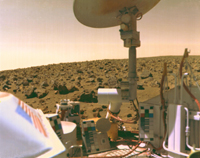 |
| Minimum Surface
Temperature: |
-140º
C |
| Average Surface
Temperature: |
-53º
C |
| Atmospheric
Composition: |
95.3% Carbon Dioxide |
| 2.7% Nitrogen |
| 0.03% Water Vapor |
| 2% Trace Elements |
Back to Top The Martian Atmosphere:
The atmosphere on Mars contains the same levels of
of carbon dioxide as
Venus, but does not demonstrate
the runaway
greenhouse effect that
Venus has. Water
vapor is also present in the Martian atmosphere but
at 30 times less than the level in
Earth's
atmosphere. The dry atmosphere is mostly due to the
lack of ozone on Mars and the lower escape velocity
so small particle within the atmosphere is free to
escape.
| The Mars Pathfinder took this photograph
of a Martian sunset. Even though the
atmosphere is thin, refraction of light and
reflective atmospheric particles are still
present enough to give the sunset a nice
color. The red an blue colors would not be
present if Mars had no atmosphere. |
 |
The presence of the atmosphere, no matter how thin,
still allows for weather patterns to occur. The most
common weather pattern on Mars are dust storms -
sometimes on a global scale.

The
Mars Global Surveyor photographed a dust-devil
on the surface. A dust-devil is like a mini-tornado
without the associated storm patterns.

The above Hubble image demonstrates a dust storm on
a global scale. These storms can last several
months.
Back to Top
Martian Surface Features:
Mars contains a number of fascinating surface
features, mostly as a result of the
Mars Global Surveyor and
Mars Exploration Rovers. While I could cover
these here, I will leave that as a resource link or
subjects for
Advanced Topics.
The three major features on Mars are:
- The Polar Caps
- Valles Marineris
- Volcanoes
(images care of
Swinburne Astronomy Online)
The Polar Caps of Mars contain mostly carbon
dioxide, but some water is present underneath.
The seasons on Mars are similar to that on
Earth in that there is a defined spring, summer,
autumn, and winter. This is evident by the
changing appearance of the polar caps:
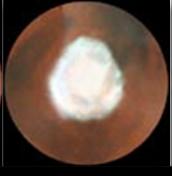 |
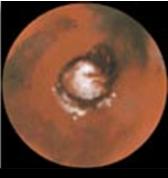 |
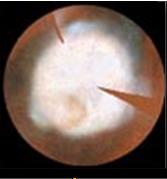 |
| Polar Caps - Spring |
Polar Caps - Summer |
Polar Caps - Winter |
The carbon dioxide is transferred to the
atmosphere during seasonal changes. Just like
Earth, there is a Northern Polar Cap and a
Southern Polar Cap.
- The Northern Polar Cap is mostly water with
carbon dioxide on the outer rims
- The Southern Polar Cap is mostly carbon
dioxide with water underneath
Canyons are another prominent feature. The Valles Marineris is similar to our Grand
Canyon, and was the first evidence of possible
water formation on Mars (since the Grand Canyon
was formed by gradual erosion as a result of the
Colorado River - and
plate tectonics played a
role as well). The second image from the top
clearly shows this region. Valles Marineris is
named after the Mariner orbiter.
Two of the three main volcanoes are visible in
this same image - on the right hand side. The
largest volcano is called Olympus Mons.
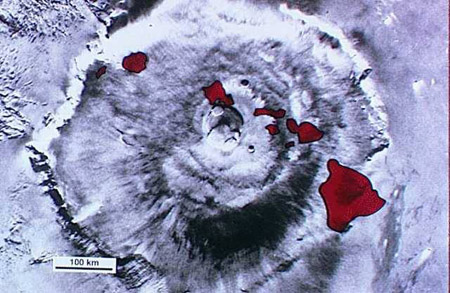
The image above shows Olympus Mons in comparison to
the Hawaiian Islands (in red). This volcano is the
largest in the Solar System.
This type of volcano is called a shield volcano
and forms not by tectonics but by upward pressure
from the mantle. Because plate tectonics is absent
from Mars, these volcanoes are free to grow to very
large diameters.
The geologic periods of Mars (or any planet) can be
determined by crater counts. Using this technique,
there are three ages, or periods, of Mars:
- Noachian Era - 4.6 to 3.7 billion years ago,
dating back to the heavy bombardment period
(where debris in the newly formed Solar System
was prominent)
- Hesperian Era - 3.7 to 1 billion years ago,
also know as the Martian middle period
- Amazonian Era - 1 billion years ago to the
present, represents the least cratered areas on
Mars (like the northern lowlands)
Back to Top |

